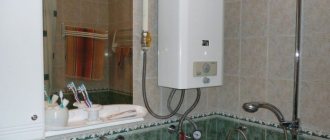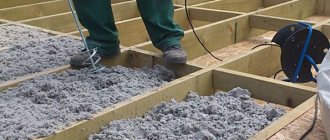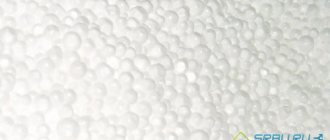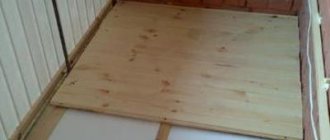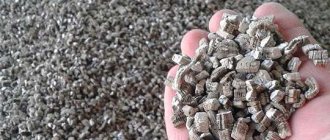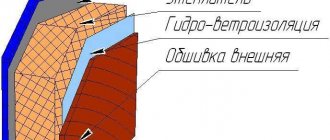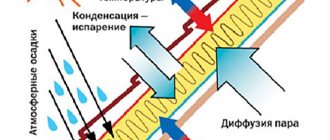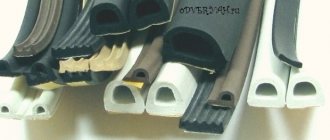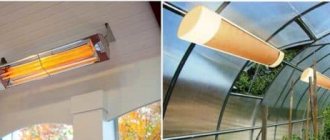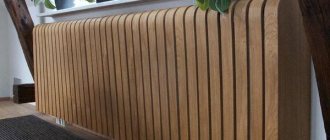Features of insulating a bathhouse made of foam blocks from the inside
The need for additional thermal insulation measures is obvious. Despite the fact that foam blocks are a material that retains heat quite well, it can freeze in severe frosts and not provide the room with the necessary comfortable temperature. And for a bathhouse, maintaining heat inside is a very important point.
Insulation of walls in a bathhouse made of foam blocks from the inside has its own characteristics. This is primarily due to the fact that this material has a porous structure into which moisture can easily penetrate. Lingering inside, it can not only significantly reduce the ability of thermal insulation, but also affect the durability of the structure itself.
Advice. In addition to insulation, use waterproofing materials. This applies to both auxiliary premises and the steam room itself.
The most popular waterproofing material is membrane film or isospan.
As for insulation materials for insulating walls from the inside, the following most popular types can be noted:
- Mineral wool - the material is excellent due to its resistance to high temperatures, withstands heating up to 1000 degrees. That is why it is popular for insulating walls directly in the steam room. Mineral wool is durable and not susceptible to rotting and the formation of mold and fungi.
- Jute felt is great for insulating the walls of a bathhouse from the inside. This natural material has high thermal conductivity and is also able to remove excess moisture from the room. Not susceptible to fungi and mold. Also suitable for insulating a steam room from the inside.
- Foil insulation is a specially developed material for insulating walls and ceilings in saunas and baths. It is great for insulating a steam room. Its main advantage is the possibility of installation without battens.
Glass wool and foam insulation are not suitable for insulating the walls of a bathhouse from the inside, since these materials are not able to withstand high temperatures, and can also release toxic substances when heated, which will in no way help maintain a healthy microclimate.
Rationale for using foam blocks to insulate a bathhouse from the inside
Foam concrete blocks belong to a group of materials that retain internal heat, but freeze at subzero temperatures, so bathhouse visitors feel discomfort. The material is hygroscopic and absorbs moisture. It is necessary to insulate a bathhouse from a block inside using technology, since the process has its own characteristics.
Comprehensive thermal insulation includes protection against moisture and steam. The protective layer is installed inside and outside, preventing the foam concrete from getting wet. Foam blocks are chosen grade M25, the density of the material should be D700.
Features of different materials for insulation
Bathhouse premises are divided into types depending on the internal microclimate. The washing room, steam room and combustion chamber have high humidity and temperature, and the rest room and dressing room have normal conditions.
The following insulation is used for bathhouse premises:
- jute felt;
- mineral wool;
- expanded clay;
- Styrofoam.
The materials are intended for different rooms, because... differ in properties and characteristics. When choosing, the hydrophobicity of the insulation and the ability to release harmful substances when heated are important.
Jute felt
Jute felt
Natural fiber from the plant of the same name is used in production. Natural resins protect the threads from rotting; the material is durable, environmentally friendly, and has a uniform density throughout the mass. Polyester fibers are used for bonding, which impart elasticity.
The peculiarity of jute is that when it is hot, it does not release toxic substances into the surrounding space. Requires film vapor and waterproofing, since the fibers get wet when in contact with moisture.
Mineral wool
Mineral wool
For production, rocks, glass, and blast furnace waste are used, which are melted in high-temperature chambers and form fibers.
There are different types of mineral wool:
- glass wool;
- stone wool;
- slag.
Glass wool absorbs moisture less than the other two types, but is also used in bath rooms in combination with steam protection. Mineral wool reacts steadfastly to the action of chemicals and, in the event of a fire, forms a barrier to the spread of flame. Getting wet reduces the heat-shielding properties.
Expanded clay
clay
Porous insulation is made from clay shale as a result of firing. Subsequent processing results in material with different bulk densities. Expanded clay can weigh from 150 to 850 kg/m3.
Environmentally friendly insulation is divided depending on shape and size:
- crushed stone;
- gravel;
- sand.
The first two varieties have a large, medium and small fraction. Sand and small-sized elements are not used to insulate a cinder block bathhouse from the inside, because... Due to the high density in the mass, it conducts internal energy faster. Large and medium granules are used, which require the construction of a special frame into which the material is poured.
Styrofoam
The material belongs to the group of foamed polymers. Gas occupies a large volume in the mass, so the structure contains isolated balls glued together during the production process. Thermal insulating properties are due to the low conductivity of the internal elements.
Polystyrene foam is well suited for insulating a bathhouse made of blocks from the inside with your own hands, because... Easily mounted on walls and does not require a frame. The material is inexpensive, but provides effective insulation from the cold. Polystyrene foam does not absorb moisture well and retains its properties for a long time.
Glass wool
Glass wool is inferior to basalt wool in thermal conductivity. Internal insulation of bathhouse walls is impossible with it, because... glass wool cannot withstand heating above 400 degrees. In addition, when this material wears out, it begins to emit an unpleasant odor, which is completely unacceptable for a bathhouse.
Insulation for buildings made of foam concrete
It is usually recommended to use natural materials as insulation for bathhouse walls due to their environmental characteristics. For interior decoration, this requirement is justified. But synthetic insulation materials are also suitable for exterior decoration and insulation of baths. What materials are most often used for insulation?
- Mineral wool is a popular material with good thermal insulation properties. It is resistant to high temperatures, withstands heating up to 1000 degrees, which allows it to be used not only for exterior, but also for interior decoration. Mineral wool is durable, resistant to biological influences, and is not susceptible to rotting or fungus formation.
- Glass wool - has slightly lower thermal conductivity than mineral wool. For such a purpose as insulating a bathhouse made of blocks from the inside, it is not suitable due to its poor reaction to high temperatures. When worn out, glass wool emits an unpleasant odor, which also makes it unsuitable for interior decoration.
- Jute felt is a natural insulation material of organic origin. Ideal for insulating bathhouse walls made of blocks inside and outside. It retains heat perfectly, is resistant to mold and mildew, has high strength and the ability to remove excess moisture from the room.
- Expanded clay is a dry granular substance consisting of small balls of baked clay. Used for insulation of horizontal surfaces - floors, ceilings of bathhouses.
- Polystyrene foam - usually used to insulate the outside of a bathhouse. They cover the facade with it, fixing it with glue or fasteners, and finish it with any chosen material - plaster, siding, panels.
Expanded clay concrete blocks are a rather controversial material that has significant advantages and the same disadvantages.
One of the most obvious is its hygroscopicity, which is completely inappropriate in a room with high humidity. This is explained by the fact that in severe frosts, blocks of expanded clay concrete saturated with moisture will freeze and collapse.
If we take into account the fact that in winter, after heating the bathhouse to very high temperatures, it remains to cool, then in one or two years the frost resistance limit will be completely exhausted.
That is why insulating a bathhouse made of expanded clay concrete blocks from the inside is simply necessary in order to avoid premature destruction of structures.
Expanded clay concrete has many more advantages:
- It is one of the most environmentally friendly materials because it is absolutely non-toxic;
- Light weight;
- Good thermal insulation properties.
The process of finishing interior walls with clapboard
Many people perform cladding using wooden lining. The advantages of wood are obvious to everyone - it is durable and beautiful, but when using it, all the nuances must be taken into account. For example, lining made from coniferous trees cannot be used where temperatures are always high, that is, in steam rooms, since when it is heated, sticky resins are released. They are dangerous to the human respiratory system. Quite often mold forms in bathhouses.
Antiseptics of various types help to cope with this, so it is better not to decorate the washing room with clapboard. Cheap pine paneling is used in dressing rooms. Deciduous trees are needed in the steam room. The most reliable and durable oak lining. However, currently aspen lining is most often used.
By all accounts, aspen is the best type of finish. The advantages are aroma, environmental friendliness, and health benefits, because when heated, some wood species release phytoncides into the environment.
Move the lining into the bathhouse itself - it should absorb excess moisture.
Before installing the finishing, complete the wiring of all communications.
Next, you need to make a wooden sheathing (for this it is better to use special screws intended only for working with foam blocks) and then everything is covered with a special solution that prevents the formation of mold.
Next, the insulation is installed. The vapor barrier material is attached with a stapler to the sheathing previously prepared for this.
Next, the lining is secured either with nails or secret clamps. Claypers are used at the finishing and decorating stage.
How to insulate a bathhouse made of foam blocks
The main task of a bathhouse is not only to create good steam, but also to keep it inside for a long time. This is especially true for a material such as foam block, which, without proper insulation, willingly gives off heat both inside and outside the room, which leads to rapid drying.
It is noteworthy that the process of insulating a bathhouse begins simultaneously with construction, from the foundation. It is recommended to use only those materials that are resistant to moisture, tolerate temperature changes well, and are difficult to break down biologically.
Construction of walls
Unprepared developers often think that building a bathhouse from foam blocks will take them a lot of time and effort. In reality, everything is much simpler. Masonry of foam blocks is carried out similarly to brickwork, and the large size of the blocks makes this activity as convenient as possible.
Tools for building a bathhouse from foam blocks
Walling
Armed with a building level, find the highest corner of the foundation. This is where you will begin the masonry work.
Walling
Lay out the walls for the first time. M25 foam blocks are optimally suited for the construction of steam room walls. To fasten the elements, use ordinary cement-sand mortar. Place the blocks on edge. Try to keep the seams between individual elements as thin as possible.
Do-it-yourself foam block wall laying technology
Align the first row of building blocks strictly level. A rubber hammer will help you with this. Be as careful as possible at this stage, since the basic operational properties of the finished structure directly depend on the correct installation of the starting row.
Proceed with laying the second row. Lay it out with a shift. To fasten the elements, use not a solution of sand and cement, but a special glue designed for the installation of specifically porous materials. Apply glue in a 0.5 cm layer. You don’t have to wait for it to dry - it doesn’t matter.
Window openings
Lay out the walls to the required height. After every third row, be sure to lay a fine-mesh metal mesh for additional reinforcement.
Foam block reinforcement
When laying out the walls, leave openings for future doors and double-glazed windows. At this point, be guided by your personal preferences.
After laying the walls, if possible, leave them for 3-4 days, and then proceed to arranging the roof structure.
Bath insulation technology
To properly insulate a bathhouse made of foam blocks, it is necessary to cover all surfaces: floor, ceiling and walls with thermal insulation materials.
Floor insulation
You need to think about floor insulation even at the stage of building a bathhouse. To increase the protection of walls from groundwater, a layer of waterproofing should be laid between the foundation and the foam block masonry. Most often, ordinary roofing felt or similar materials are used for this.
Having erected the walls, you can proceed directly to the equipment and insulation of the floor. All work in this direction is as follows:
- The earthen base is leveled and covered with thick polyethylene in several layers. This is done to prevent moisture from seeping into the insulation layer.
- Then a layer of expanded clay, at least 10–15 cm, is poured in and compacted thoroughly.
- You need to make a cement screed on top of the expanded clay. In this case, you should use a reinforcing mesh, which can be placed directly on the expanded clay or buried in the thickness of the mortar during the process of pouring the floor.
- The top layer of the screed must be carefully leveled using a long rule.
After the cement screed has dried, the rough floor of the bathhouse is ready. Now it can be tiled with ceramic tiles or a wooden floor can be made.
Outside
The main load lies on the external decoration of the house or bathhouse made of foam concrete. It is necessary to completely cover the shortcomings of cellular concrete and at the same time ensure optimal characteristics of the entire enclosing structure.
The best option is an insulated ventilated facade. It allows you to use insulation with low vapor permeability and reliably protect foam concrete from external factors. The aesthetic appearance of a ventilated façade is also a major advantage.
The following insulation materials can be used:
- basalt wool, mineral wool;
- cellulose;
- expanded polystyrene;
- jute felt.
Materials such as polyurethane foam or extruded polystyrene foam (EPS) are absolutely not suitable, as they do not provide adequate vapor permeability, which can lead to strong moisture in the foam blocks and their rapid destruction.
The surface of the wall is treated with soil and penetrating waterproofing. A heat insulator is laid over a lathing made of wood or a metal profile. To protect against external factors, the insulation is protected by a membrane that covers the entire plane of the wall.
A counter-lattice is installed to form a ventilation gap. It fixes the vapor-permeable membrane and ensures free air movement. The counter-lattice beams are attached on top of the first layer, and each batten is divided into two unequal parts and mounted so that there is a gap of 10-15 cm between them. This will ensure the transverse movement of air.
Lastly, the sheathing is installed under the siding, which is boards, lining, PVC panels or metal wall panels for ventilated facades.
Exterior insulation scheme using a ventilated façade method
Ventilation gaps are installed along the lower edge of the facade and under the roof canopy. It is advisable to cover them with protective grilles to prevent rodents from penetrating into the insulating layer and damaging it.
It is also allowed to paste the walls of the house with thermal insulation followed by plastering. The main thing is to choose the required thickness of the material.
Wooden floors
Wooden floors are insulated in a different way than concrete floors. For these purposes, more suitable polystyrene foam boards and foamed polymers are ecowool or Icing foam.
Insulation of wooden floors includes the following steps:
- The bars are ground to the very bottom edge of the main beams; they will be indispensable for constructing a subfloor.
- Pre-cut boards are laid between the beams on bars; the dimensions of these boards should be slightly smaller than the distance between adjacent beams. It is better to use low-grade wood for the construction of the cranial floor.
- A waterproofing membrane with a vapor-protective film is laid over the resulting layer; it should cover the entire area of the wooden floor structure. Expensive film can be replaced with sheets of roofing material with seams taped with bitumen mastic.
- Insulation is laid on this layer, on top of which the finishing floor boards are mounted and baseboards are installed.
Concrete floors
If you decide to pour a concrete floor, then the bottom slabs or subfloor on the ground are thoroughly protected from the harmful effects of moisture. For these purposes, you can use rolled material in 1 layer or coating mastic in 3-4 layers. An alternative is to combine these types of waterproofing materials, after which the selected insulation is installed. If it is expanded clay, then it can also be mixed into the concrete screed. By the way, you can also insulate it with a layer of 25 cm of foam concrete of lower density. A reinforcing mesh is mounted on the installed insulating layer, this is done to prevent destruction of the concrete coating. After strengthening the floor, a concrete screed is laid on the reinforcement frame. The finishing coating depends on the wishes of the owner of the future bathhouse.
Ceiling insulation
Without reliable thermal insulation of the ceiling, it is impossible to properly insulate the bathhouse from the inside. More than 90% of thermal energy rises to the ceiling and evaporates. There are two methods for insulating the ceiling:
- The first method requires the use of foil, which is placed on the ceiling of the bathhouse from the attic side. Then the foil is covered with a layer of waterproofing and the entire space between the rafters is filled with fine expanded clay. Then the expanded clay is covered with another layer of plastic film on top and the roof can be installed.
- The second method is more suitable for a bathhouse with an attic. In this case, instead of expanded clay, you can fill the ceiling with clay mixed with sawdust. The effective layer of such coating is 20–25 cm.
Wall insulation
In order to properly insulate the walls of a bathhouse from the inside, it is necessary to use frame technology:
- Wooden sheathing is mounted on foam block walls.
- A layer of waterproofing material is installed.
- Insulation is being installed.
- Then you need to install another layer of vapor barrier.
Advice! To increase thermal insulation properties, it is best to choose a vapor barrier material based on foil. This will shield thermal energy, thereby reducing heat loss.
Based on the above material, it is quite easy to insulate a bathhouse. A distinctive feature of such work for a structure made of foam blocks is the use of a large amount of waterproofing material. A properly insulated sauna will last a long time and bring a lot of positive emotions.
Attic insulation
To insulate the attic, you can use mineral wool.
If the bathhouse is built with a technical upper floor, it is insulated along the covering, walls and slopes.
Materials used for the horizontal layer:
- slag;
- expanded clay;
- felt;
- Styrofoam.
Insulation of walls and ceilings in the attic is done according to the insulation scheme for similar surfaces in the bathhouse.
Features of the technological process
Insulation materials have low thermal conductivity, which is maintained through the use of vapor barrier and moisture barrier films. Before work, you need to study the step-by-step instructions for insulating the inside of a brick bath or sauna made of foam concrete blocks with your own hands.
Insulating only the walls will not work, since energy escapes through the walls and ceiling of the steam room. Horizontal and vertical structures are insulated according to the rules in order to reduce fuel consumption and reduce heating costs.
Floor insulation
Foam plastic or extruded polystyrene foam is more often used. The ground under the floor is dug to a depth of 40-50 cm from the level of the clean floor, then a layer of sand and crushed stone bedding is poured to a height of 20-25 cm. A screed of cement and sand is applied over the cushion or poured with cement laitance to fasten the components.
Waterproofing consists of a triple coating layer of bitumen or 3 layers of roofing material are laid on mastic. After this, insulation is laid, which is protected by a vapor barrier membrane and waterproofing film. A cement-sand screed is made, on top of which a final floor covering is made.
Vapor barrier of walls
Most often, polyethylene film is used to protect against the penetration of moist air, but there are other materials that are more effective.
Depending on the type of room, the following are used:
- the steam room is equipped with foil insulation, which additionally reflects infrared waves;
- foil or cellophane, kraft paper with a moisture-resistant layer and a lavsan coating are installed in the shower;
- the rest room and vestibule are finished with simple kraft paper, membrane insulators, and glassine.
Flexible foam plastic with a foil coating on one or both sides works well in the steam room. The material can simultaneously get rid of moisture and properly insulate a bathhouse from the inside made of foam blocks, if you select the thickness in accordance with the calculation.
Ceiling insulation
To attach the insulation to the ceiling, a frame is made of wooden slats or a metal profile that supports the layer. The elements are placed at intervals of 50 cm.
Vapor and waterproofing is installed at the bottom of the material so that the film does not come into contact with the insulation. Condensation forms on the moisture-proof membrane, which is transferred to the thermal protection and reduces its properties. The ceiling trim is mounted on the frame.
Attic insulation
If the bathhouse is built with a technical upper floor, it is insulated along the covering, walls and slopes.
Materials used for the horizontal layer:
Insulation of walls and ceilings in the attic is done according to the insulation scheme for similar surfaces in the bathhouse.
Insulation of washroom and rest room walls made of foam blocks
Insulation of other rooms of a bathhouse made of gas blocks can also be done with basalt wool or expanded polystyrene 100 mm thick.
Unlike a steam room, these rooms do not require resistance to high temperatures, so polystyrene foam may be a good choice.
The advantages of insulation made from this material include:
- resistance to getting wet;
- resistance to the spread of mold and fungi;
- high thermal characteristics.
Expanded polystyrene is laid between bars having a thickness equal to the thickness of the insulation, from which a frame is made on the inside of the walls made of foam blocks, on top of which a foil hydro-vapor barrier is spread, the joints of which are carefully sealed with metallized tape.
Let's talk about how to properly insulate a bathhouse made of foam blocks
The main purpose of any bathhouse is to create and maintain a constant high temperature inside it and (if it is a so-called Russian bathhouse and its analogues) the formation of water vapor in the air, which has a beneficial effect on human health, helps cleanse the body, remove toxins - and simply gives great pleasure .
If the bathhouse is built from foam blocks, then it must be insulated - this is the most important part of the measures for its proper functioning.
Finishing the bath from the outside
Due to the fact that we already have the necessary wooden frame, all we have to do is find high-quality material for the exterior decoration of the bathhouse. Only after this the insulation of the bathhouse can be completed. Most often, wooden lining is used for the external cladding of bathhouses in Russia.
Example of façade cladding with clapboard
In conclusion, to all of the above, it would not be superfluous to pay attention to interesting and useful advice from experts.
Insulation of a steam room made of foam blocks
A bathhouse is a place with high humidity, under the influence of which even the most reliable material can rot and collapse. That is why it is recommended to carry out exterior finishing using ventilated facade technology. For such a system, more suitable materials are such as polystyrene foam, basalt wool in slabs of standard sizes and jute fiber.
Among this variety, I would like to note basalt insulation. It is good in everything: it holds heat better than other materials, despite its small thickness, it does not burn, it is durable and environmentally friendly and safe, and in addition it performs noise-insulating functions.
The installation of insulation on a ventilated facade system occurs in several stages:
- In order to properly secure the insulating material, first of all you need to install the grooves on which it will be mounted; they can be made from ordinary angles. The distance between them should be equal to the width of the insulation.
- After fixing the material, all joints are properly waterproofed, and if there is a need for this, it is additionally secured to the wall with dowels. The exception is basalt insulation; it is so elastic that it holds its shape perfectly without auxiliary materials.
- After that, a roll waterproofing material is laid around the entire perimeter. It can be secured using slats.
- On top of this entire structure, guides are placed for the installation of facing materials.
To carry out insulation work inside a bathhouse, you can use the following materials: expanded clay, mineral (including basalt) wool and jute felt.
On top of the insulation, the walls of the steam room can be finished with any environmentally friendly material that does not emit any harmful substances when heated and has good resistance to moisture and elevated temperatures.
The most popular finishing is made from hardwood lining - linden, cedar, larch.
You can also use tile finishing, which is laid on GVLV sheets (for example, Knauf supersheet with a straight (PC) or folded (FC) edge). To glue tiles in a steam room, it is recommended to use:
- Plitonite “super fireplace” is heat-resistant, reinforced, for tiling walls in the area where the stove is installed and the chimney is laid.
- Knauf tile standard for gluing tiles to the shelf level.
- Knauf reinforced fixation “elastic” (“Flex”) for all other areas.
Tips and tricks
- First of all, do not forget that heated air masses can exit the bathhouse through the windows. And for this reason, you should give preference to small windows. What is also important, experts recommend, if possible, installing frames with more than one double-glazed window. And it is best to have 2 or 3 double-glazed windows (the more, the better, because this will prevent the rapid evaporation of warm air from the bathhouse).
Small window in the bathhouse - photo
- Doors and thresholds have an important influence on the thermal insulation in your bathhouse. Quite often, specialists are contacted with the problem of rapid evaporation of air from the bathhouse. And the reason for this in 90% is the gap between the threshold and the door, due to which all the heat evaporates. To be sure that you will not encounter a similar problem, it is best to install low doors with a high threshold.
It is recommended to install small doors with a high threshold
- Due attention should be paid to the heater. After all, the intensity of heating the bath and how long the warm air will be retained in it will directly depend on the heat capacity of the stones.
Stove-heater
